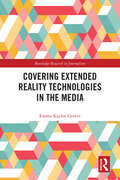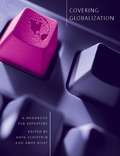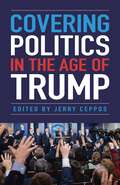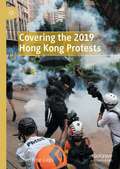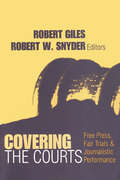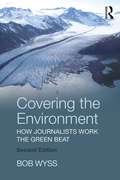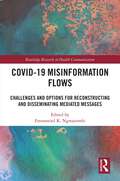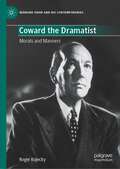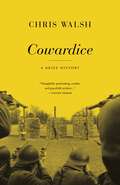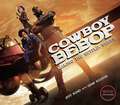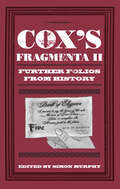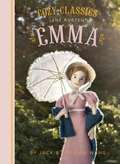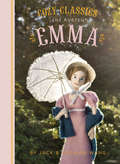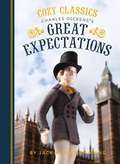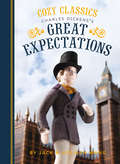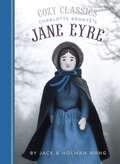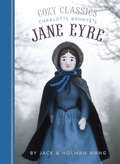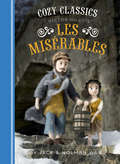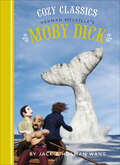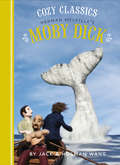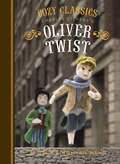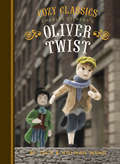- Table View
- List View
Covering Extended Reality Technologies in the Media (Routledge Research in Journalism)
by Emma Kaylee GravesThis book presents a study of the news coverage of extended reality technologies (virtual, augmented and mixed reality; or XR) and how this news corresponds with the marketing of XR products. Focusing on a group of recently emerging technological products, the book offers in-depth analysis of the news coverage of XR technologies and explores the overlap between news discourse and promotional discourse by comparing the way these products are framed in the news and their marketing materials. Using both quantitative and qualitative data, it discusses the topics covered in XR news, as well as the sources used and the specific framing techniques that appear in both XR news and marketing materials. In addition to these findings, it also provides a set of frame categories that can be used by other researchers analysing the media coverage of emerging technologies. Ultimately arguing that the news represents XR in such a way that treats readers as consumers instead of citizens, prioritising the interests of XR companies rather than news audiences, this book will be of interest to students and researchers in media and communications, discourse studies, journalism, PR and marketing and innovation studies, as well as XR practitioners.
Covering Globalization: A Handbook for Reporters
by Amer Bisat Schiffrin AnyaThe first journalism textbook for reporters who cover finance and economics in developing and transitional countries, Covering Globalization is an essential guide to the pressing topics of our times. Written by economists from the Asian Development Bank and the International Monetary Fund as well as journalists who have worked for Dow Jones, the Financial Times, the New York Times, Fortune, and Reuters--and with an introduction by Nobel Laureate Joseph E. Stiglitz--this invaluable resource helps reporters write about subjects such as banking and banking crises, pension reform, privatization, trade agreements, central banks, the World Bank, sovereign debt restructuring, commodity markets, corporate governance, poverty-eradication programs, and the "resource curse." Each chapter explains the basic economic principles and current thinking on a given topic and provides tips on what to look for when covering specific subjects; a way to structure business and economics stories; a way to use the Internet for reporting with links to more information online; extensive glossaries and much more.
Covering Globalization: A Handbook for Reporters
by Amer Bisat Schiffrin Anya Eds.The first journalism textbook for reporters who cover finance and economics in developing and transitional countries, Covering Globalization is an essential guide to the pressing topics of our times. Written by economists from the Asian Development Bank and the International Monetary Fund as well as journalists who have worked for Dow Jones, the Financial Times, the New York Times, Fortune, and Reuters—and with an introduction by Nobel Laureate Joseph E. Stiglitz—this invaluable resource helps reporters write about subjects such as banking and banking crises, pension reform, privatization, trade agreements, central banks, the World Bank, sovereign debt restructuring, commodity markets, corporate governance, poverty-eradication programs, and the "resource curse." Each chapter explains the basic economic principles and current thinking on a given topic and provides tips on what to look for when covering specific subjects; a way to structure business and economics stories; a way to use the Internet for reporting with links to more information online; extensive glossaries and much more.
Covering Politics in the Age of Trump
by Jerry CepposLike politics, journalism has been turned topsy-turvy by the presidency of Donald Trump. Covering Politics in the Age of Trump takes a wide-ranging view of the relationship between the forty-fifth president and the Fourth Estate. In concise, illuminating, and often personal essays, twenty-four top journalists address topics such as growing concerns about political bias and journalistic objectivity; increasing consternation about the media’s use of anonymous sources; the practices journalists employ to gain access to wary administration officials; and reporters’ efforts to improve journalism in an era of twenty-four-hour cable news. Contributors include: Mark Ballard, Peter Bhatia, Rebecca Buck, Carl Cannon, Jill Colvin, Charlie Cook, McKay Coppins, Mary C. Curtis, Paul Farhi, Quint Forgey, Major Garrett, Ginger Gibson, “Fin” Gomez, Jesse J. Holland, Clark Hoyt, Sarah Isgur, Mark Leibovich, Ashley Parker, Fernando Pizarro, Tom Rosenstiel, Frank Sesno, Alexis Simendinger, Steve Thomma, and Salena Zito.The Trump administration’s contentious relationship with the media has altered the public’s expectations regarding the news and national politics. In Covering Politics in the Age of Trump, top political reporters explore this dynamic, relaying stories from the campaign trail to the briefing room that illustrate the new challenges faced by journalists working in the age of “fake news.”
Covering the 2019 Hong Kong Protests
by Luwei Rose LuqiuThis book explores the impact of governmental, institutional, and individual factors on journalists covering protests, using the 2019 Hong Kong Anti-Extradition Bill Movement as a case study. The discussion surveys the challenges frontline journalists have faced while covering protests that unfolded in complex and rapidly evolving geopolitical contexts and media ecologies. Complementing this is an analysis of the Chinese government’s efforts to suppress social movements by curtailing press freedom to silence criticism of the government and keep information about the protest efforts from the public. Separate chapters explore these issues from the perspectives of the citizen journalists, student journalists, and independent journalists who have played key roles in the most recent social movements in Hong Kong. It concludes with a look at the future of press freedom in the city after the passage of the National Security Law.
Covering the Courts: Free Press, Fair Trials, and Journalistic Performance (Media Studies)
by Robert GilesCovering the Courts shows how writers and journalists deal with present-day major trials, such as those involving Timothy McVeigh and O.J. Simpson. The volume features such outstanding contributors as Linda Deutsch and Fred Graham, and provides an in-depth look at the performance of the court in an age of heightened participation by reporters, camera operators, social scientists, major moguls of network radio and television, and advocates of special causes.The volume does far more than discuss specific cases. Indeed, it is a major tool in the study of the new relationships between a free press and a fair trial. Interestingly, a consensus is described in which the parties involved in efforts to balance freedom of the press and the right to a fair trial are moving in tandem. In this regard, sensitive issues ranging from the universality of law to the particularity of racial, religious, and gender claims, are explored with great candor.The volume also turns the intellectual discourse to its major players: the members of the press, the lawyers, and the judiciary. Has there been a shift from reporting functions to entertainment values? Does television and live presentation shift the burden from the contents of a case to the photogenic and star quality of players? What excites and intrigues the public: serious disturbances to the peace and mass mayhem, such as the Oklahoma bombings or sexual adventures of entertainment and sports figures? The findings are sometimes disturbing, but the reading is never dull. This book will be of interest to journalists, lawyers, and the interested general public.This volume is the latest in the Transaction Media Studies Series edited by Everette E. Dennis, dean of the school of communication at Fordham University. The volume itself is edited by Robert Giles, the editor, and Robert W. Snyder, the managing editor, of Media Studies Journal. The original contributions were initially presented at The Freedom Forum and its Media Studies Center.
Covering the Environment: How Journalists Work the Green Beat
by Bob WyssThis practical primer explains the primary issues in writing about the environment, identifies who to go to and where to find sources, and offers examples of writing and reporting the beat. Observations and story excerpts from experienced journalists provide real-world context both for those in the U.S. as well as internationally. Practice story assignments, resources, and a glossary of critical terms gives budding journalists all the tools needed to cover the green beat. Updated with detailed coverage of how companies and climate change have evolved over the past decade, this second edition expands upon the digital sphere and the myriad ways that deadline, multimedia and mobile reporting have changed environmental journalism. Including consideration of issues such as the water crisis in Flint, Michigan, and the GMO controversy, this new edition provides a fresh take on the green beat with a newly organized table of contents and a guide to freelance and entrepreneurial journalism anywhere in the world. Contents include: • an overview and history of the environment and journalism, spotlighting the most significant issues in the beat; • guidance on understanding environmental and health science, ranging from issues of risk, to scientific research and studies, to interviewing scientists; • insights into government and regulatory communities and environmental advocates on all sides of the political spectrum and internationally; • assistance in accessing public records and conducting digital and computer-assisted reporting; • guidance in writing the story for print, broadcast and internet audiences; • an examination of the future of journalism and news coverage of the environment in the U.S. and throughout the world.
Covid-19 Misinformation Flows: Challenges and Options for Reconstructing and Disseminating Mediated Messages (Routledge Research in Health Communication)
by Emmanuel K. NgwainmbiCovid-19 Misinformation Flows describes challenges in accessing, collecting, processing, and disseminating information on pandemics, with a focus on Covid-19 communication.An international team of authors addresses the role of disinformation and misinformation in managing the communication of epidemics; how social media platforms and mainstream media outlets in some countries and regions address pandemics in the context of the flow, learning, and sharing of information on Covid-19. Looking at how traditional media and social media report pandemics, especially Covid-19, the volume addresses the effect of fake news on individuals and businesses, and the impact of such communication on physical and mental health.This book will interest scholars and students of health communication, social media communication, journalism, political communication, and media and communication in the Global South.
Coward the Dramatist: Morals and Manners (Bernard Shaw and His Contemporaries)
by Roger KojeckyDiscussions of Coward’s achievement in the theatre between 1920 and 1966 have tended to stay with the colourful biography. The more analytical literary approach adopted here places Coward’s success in its wider theatrical context, making the connections with the work of other dramatists. He developed his technique according to what worked with theatre audiences. Taking up the well-made play, he brought in a more colloquial dialogue, explored, for instance, the morality and psychology of marriage and free love, and frequently exploited the dramatic possibilities of characters grouped into two camps. The book considers both the ‘pleasant’ and ‘unpleasant’ plays (to use the Shavian terms), and the episodic patriotic plays. It Includes Coward’s ambivalent approach to the ‘theatre of war’ in the 20th century. (123)
Cowardice: A Brief History
by Chris WalshA provocative look at how cowardice has been understood from ancient times to the presentCoward. It's a grave insult, likely to provoke anger, shame, even violence. But what exactly is cowardice? When terrorists are called cowards, does it mean the same as when the term is applied to soldiers? And what, if anything, does cowardice have to do with the rest of us? Bringing together sources from court-martial cases to literary and film classics such as Dante's Inferno, The Red Badge of Courage, and The Thin Red Line, Cowardice recounts the great harm that both cowards and the fear of seeming cowardly have done, and traces the idea of cowardice’s power to its evolutionary roots. But Chris Walsh also shows that this power has faded, most dramatically on the battlefield. Misconduct that earlier might have been punished as cowardice has more recently often been treated medically, as an adverse reaction to trauma, and Walsh explores a parallel therapeutic shift that reaches beyond war, into the realms of politics, crime, philosophy, religion, and love.Yet, as Walsh indicates, the therapeutic has not altogether triumphed—contempt for cowardice endures, and he argues that such contempt can be a good thing. Courage attracts much more of our attention, but rigorously understanding cowardice may be more morally useful, for it requires us to think critically about our duties and our fears, and it helps us to act ethically when fear and duty conflict.Richly illustrated and filled with fascinating stories and insights, Cowardice is the first sustained analysis of a neglected but profound and pervasive feature of human experience.
Cowboy Bebop: Making The Netflix Series
by Jeff Bond Gene KozickiOfficial companion book to the Netflix TV series featuring concept art, sketches, behind-the-scenes photography and interviews with cast and crew.Based on the worldwide phenomenon from Sunrise Inc., Cowboy Bebop is the jazz-inspired, genre-bending story of a rag-tag crew of bounty hunters on the run from their pasts as they hunt down the solar system&’s most dangerous criminals. They&’ll even save the world…for the right price. Take a trip behind the scenes of Netflix&’s live-action Cowboy Bebop adaptation! This official companion book is packed full of beautiful concept art and revealing behind-the-scenes photography, as the cast and crew tell the story of how one of the most influential anime series of all time was translated over to live action in this much-anticipated series.
Cowley's Essays
by Abraham CowleyThe calm spirit of Cowley's "Essays" was in all his life. As he tells us in his Essay "On Myself," even when he was a very young boy at school, instead of running about on holidays and playing with his fellows, he was wont to steal from them and walk into the fields, either alone with a book or with some one companion, if he could find any of the same temper.
Cox's Fragmenta II: Further Folios from History
by Simon MurphyA presumptuous bear imposing on a coachful of ladies, how to behave in the British Museum, the dangers of dallying with a black-eyed girl and the Royal Navy’s inaugural biscuit machine are just some of the masterpieces of understated journalism collected by Francis Cox and contained in his Fragmenta. At ninety-four volumes, Cox’s scrapbook has to be one of the largest collections of journalistic ephemera ever. For sixty years during the late eighteenth and early nineteenth centuries he accumulated articles on everything from duels to playhouses, and foreign travel to warfare. Following on from the success of the first volume, Simon Murphy has selected more bizarre stories to create another delightful historical miscellany which will intrigue and amuse.
Cozy Classics: Emma
by Holman Wang Jack WangCuddle up with a classic! In twelve needle-felted scenes and twelve child-friendly words, each book in this ingenious series captures the essence of a literary masterpiece. Simple words, sturdy pages, and a beloved story make these books the perfect vehicle for early learning with an erudite twist. Budding bookworms will delight in this clever retelling of the classics made just for them!Jane Austen's Emma tells of a well-to-do young lady who loves to play the matchmaker, and the many surprises she encounters as she attempts to secure a happy ending for her friends--and for herself. It's a first words primer for your literary little one!The Cozy Classics series is the brainchild of two brothers, both dads, who were thinking of ways to teach words to their very young children. They hit upon the classics as the basis for their infant primers, and the rest, as they say, is history. From Moby Dick to Pride and Prejudice, here are The Great Books of Western Literature for toddlers and their parents in ebook form--a little bit serious, a little bit ironic, and entirely funny and clever.
Cozy Classics: Emma (Cozy Classics)
by Holman Wang Jack WangCuddle up with a classic! In twelve needle-felted scenes and twelve child-friendly words, each book in this ingenious series captures the essence of a literary masterpiece. Simple words, sturdy pages, and a beloved story make these books the perfect vehicle for early learning with an erudite twist. Budding bookworms will delight in this clever retelling of the classics made just for them!Jane Austen's Emma tells of a well-to-do young lady who loves to play the matchmaker, and the many surprises she encounters as she attempts to secure a happy ending for her friends—and for herself. It's a first words primer for your literary little one!The Cozy Classics series is the brainchild of two brothers, both dads, who were thinking of ways to teach words to their very young children. They hit upon the classics as the basis for their infant primers, and the rest, as they say, is history. From Moby Dick to Pride and Prejudice, here are The Great Books of Western Literature for toddlers and their parents in ebook form—a little bit serious, a little bit ironic, and entirely funny and clever. Plus, this is the fixed format version, which looks almost identical to the print edition.
Cozy Classics: Great Expectations
by Holman Wang Jack WangCuddle up with a classic! In twelve needle-felted scenes and twelve child-friendly words, each book in this ingenious series captures the essence of a literary masterpiece. Simple words, sturdy pages, and a beloved story make these books the perfect vehicle for early learning with an erudite twist. Budding bookworms will delight in this clever retelling of the classics made just for them!Charles Dickens' Great Expectations introduces the orphan boy Pip, a very pretty young lady, and Pip's exciting adventures in the city. It's a first words primer for your literary little one!The Cozy Classics series is the brainchild of two brothers, both dads, who were thinking of ways to teach words to their very young children. They hit upon the classics as the basis for their infant primers, and the rest, as they say, is history. From Moby Dick to Pride and Prejudice, here are The Great Books of Western Literature for toddlers and their parents in board book form--a little bit serious, a little bit ironic, entirely funny and clever, and always welcome.
Cozy Classics: Great Expectations (Cozy Classics)
by Holman Wang Jack WangCuddle up with a classic! In twelve needle-felted scenes and twelve child-friendly words, each book in this ingenious series captures the essence of a literary masterpiece. Simple words, sturdy pages, and a beloved story make these books the perfect vehicle for early learning with an erudite twist. Budding bookworms will delight in this clever retelling of the classics made just for them!Charles Dickens' Great Expectations introduces the orphan boy Pip, a very pretty young lady, and Pip's exciting adventures in the city. It's a first words primer for your literary little one!The Cozy Classics series is the brainchild of two brothers, both dads, who were thinking of ways to teach words to their very young children. They hit upon the classics as the basis for their infant primers, and the rest, as they say, is history. From Moby Dick to Pride and Prejudice, here are The Great Books of Western Literature for toddlers and their parents in board book form—a little bit serious, a little bit ironic, entirely funny and clever, and always welcome.
Cozy Classics: Jane Eyre
by Holman Wang Jack WangCozy Classics is the popular board book series that distils great works of literature into 12 child-friendly words. Accompanied by 12 stunning images of needle-felted characters, the cuteness and visual simplicity of the felted illustrations will appeal to children, while their craftsmanship will appeal to adults. Jane Eyre is Charlotte Bronte's mysterious romance about a young governess who discovers a terrible secret about the man she loves. One of the nation's favourite reads, this Victorian classic can now be shared with younger readers.
Cozy Classics: Jane Eyre (Cozy Classics)
by Holman Wang Jack WangCuddle up with a classic! In twelve needle-felted scenes and twelve child-friendly words, each book in this ingenious series captures the essence of a literary masterpiece. Simple words and a beloved story make this ebook the perfect vehicle for early learning with an erudite twist. Budding bookworms will delight in this clever retelling of the classics made just for them!In Charlotte Brontë's Jane Eyre, a frightened little girl becomes a determined young woman who learns to love and care for the imposing Mr. Rochester. It's a first words primer for your literary little one!The Cozy Classics series is the brainchild of two brothers, both dads, who were thinking of ways to teach words to their very young children. They hit upon the classics as the basis for their infant primers, and the rest, as they say, is history. From Moby Dick to Pride and Prejudice, here are The Great Books of Western Literature for toddlers and their parents in ebook form—a little bit serious, a little bit ironic, entirely funny and clever, and always a welcome read.
Cozy Classics: Les Misérables (Cozy Classics)
by Holman Wang Jack WangCuddle up with a classic! In twelve needle-felted scenes and twelve child-friendly words, each book in this ingenious series captures the essence of a literary masterpiece. Simple words, sturdy pages, and a beloved story make these books the perfect vehicle for early learning with an erudite twist. Budding bookworms will delight in this clever retelling of the classics made just for them!In Victor Hugo's Les Misérables, a poor thief mends his ways, a sad little girl escapes a hard life, and a young couple finds love during a rebellion in Paris. It's a first words primer for your literary little one!The Cozy Classics series is the brainchild of two brothers, both dads, who were thinking of ways to teach words to their very young children. They hit upon the classics as the basis for their infant primers, and the rest, as they say, is history. They hit upon the classics as the basis for their infant primers, and the rest, as they say, is history. From Moby Dick to Pride and Prejudice, here are The Great Books of Western Literature for toddlers and their parents in ebook form—a little bit serious, a little bit ironic, and entirely funny and clever. Plus, this is the fixed format version, which looks almost identical to the print edition.
Cozy Classics: Les Misérables
by Holman Wang Jack WangCuddle up with a classic! In twelve needle-felted scenes and twelve child-friendly words, each book in this ingenious series captures the essence of a literary masterpiece. Simple words, sturdy pages, and a beloved story make these books the perfect vehicle for early learning with an erudite twist. Budding bookworms will delight in this clever retelling of the classics made just for them!In Victor Hugo's Les Misérables, a poor thief mends his ways, a sad little girl escapes a hard life, and a young couple finds love during a rebellion in Paris. It's a first words primer for your literary little one!The Cozy Classics series is the brainchild of two brothers, both dads, who were thinking of ways to teach words to their very young children. They hit upon the classics as the basis for their infant primers, and the rest, as they say, is history. They hit upon the classics as the basis for their infant primers, and the rest, as they say, is history. From Moby Dick to Pride and Prejudice, here are The Great Books of Western Literature for toddlers and their parents in ebook form--a little bit serious, a little bit ironic, and entirely funny and clever.
Cozy Classics: Moby Dick
by Holman Wang Jack WangCuddle up with a classic! In twelve needle-felted scenes and twelve child-friendly words, each book in this ingenious series captures the essence of a literary masterpiece. Simple words, sturdy pages, and a beloved story make these books the perfect vehicle for early learning with an erudite twist. Budding bookworms will delight in this clever retelling of the classics made just for them!In Herman Melville's Moby Dick, meet an enterprising young sailor, tremble at the fierce Captain Ahab, and follow their thrilling pursuit of the white whale. It's a first words primer for your literary little one!The Cozy Classics series is the brainchild of two brothers, both dads, who were thinking of ways to teach words to their very young children. They hit upon the classics as the basis for their infant primers, and the rest, as they say, is history. From Moby Dick to Pride and Prejudice, here are The Great Books of Western Literature for toddlers and their parents in board book form--mdash;a little bit serious, a little bit ironic, entirely funny and clever, and always welcome.
Cozy Classics: Moby Dick (Cozy Classics)
by Holman Wang Jack WangCuddle up with a classic! In twelve needle-felted scenes and twelve child-friendly words, each book in this ingenious series captures the essence of a literary masterpiece. Simple words, sturdy pages, and a beloved story make these books the perfect vehicle for early learning with an erudite twist. Budding bookworms will delight in this clever retelling of the classics made just for them!In Herman Melville's Moby Dick, meet an enterprising young sailor, tremble at the fierce Captain Ahab, and follow their thrilling pursuit of the white whale. It's a first words primer for your literary little one!The Cozy Classics series is the brainchild of two brothers, both dads, who were thinking of ways to teach words to their very young children. They hit upon the classics as the basis for their infant primers, and the rest, as they say, is history. From Moby Dick to Pride and Prejudice, here are The Great Books of Western Literature for toddlers and their parents in board book form—mdash;a little bit serious, a little bit ironic, entirely funny and clever, and always welcome.
Cozy Classics: Oliver Twist
by Holman Wang Jack WangCuddle up with a classic! In twelve needle-felted scenes and twelve child-friendly words, each book in this ingenious series captures the essence of a literary masterpiece. Simple words, sturdy pages, and a beloved story make these books the perfect vehicle for early learning with an erudite twist. Budding bookworms will delight in this clever retelling of the classics made just for them! In Charles Dickens'sOliver Twist, an orphan boy on thestreets of London falls in with abad crowd of pickpockets and thieves. Will Oliver ever find hisfamily? It's a first words primer for your literary little one! The Cozy Classics series is the brainchild of two brothers, both dads, who were thinking of ways to teach words to their very young children. They hit upon the classics as the basis for their infant primers, and the rest, as they say, is history. From Moby Dick to Pride and Prejudice, here are The Great Books of Western Literature for toddlers and their parents in board book form--a little bit serious, a little bit ironic, entirely funny and clever, and always a welcome gift.
Cozy Classics: Oliver Twist (Cozy Classics)
by Holman Wang Jack WangCuddle up with a classic! In twelve needle-felted scenes and twelve child-friendly words, each book in this ingenious series captures the essence of a literary masterpiece. Simple words and a beloved story make this ebook the perfect vehicle for early learning with an erudite twist. Budding bookworms will delight in this clever retelling of the classics made just for them!In Charles Dickens's Oliver Twist, an orphan boy on the streets of London falls in with a bad crowd of pickpockets and thieves. Will Oliver ever find his family? It's a first words primer for your literary little one!The Cozy Classics series is the brainchild of two brothers, both dads, who were thinking of ways to teach words to their very young children. They hit upon the classics as the basis for their infant primers, and the rest, as they say, is history. From Moby Dick to Pride and Prejudice, here are The Great Books of Western Literature for toddlers and their parents in ebook form—a little bit serious, a little bit ironic, entirely funny and clever, and always a welcome read.
